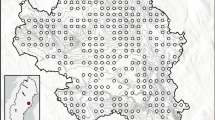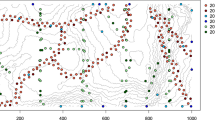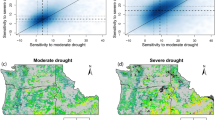Abstract
Selected data on site, vegetation cover, and soil, including soil moisture regime (SMR), were collected from 2 167 field plots in northwestern Ontario, Canada. SMR provides an estimate of an averaged, “annualized” soil moisture supply throughout a complete vegetation cycle. SMR is based upon a relative scale that subjectively ranks sites from θ, 0, and 1 through 9 along a soil moisture continuum which relates to a dry to wet gradient. SMR may be generally correlated to tree growth, stand composition, degree of competition, nutrient availability and overall site quality.
This paper reports on relationships between SMR and major tree species. Results highlight relationships between SMR class and the broad ecological ranges of several tree species. In northwestern Ontario, the determination of SMR can help resource managers to better understand the ecology of boreal sites.
Similar content being viewed by others
References
BradyN.C.: 1984, The Nature and Properties of Soils (9th edition), MacMillan Publ. Co. Inc., New York, 750 pp.
ComeauP.G., ComeauM.A. and UtzigG.F.: 1982, ‘A guide to plant indicators of moisture for southeastern British Columbia, with engineering interpretations’, Land Manage. Handb. No. 5, B.C. Min. For., Victoria, British Columbia, 119 pp.
HillM.O.: 1979, DECORANA, a Fortran Program for Detrended Correspondence Analysis and Reciprocal Averaging, Dep. Ecol. and System., Cornell Univ., Ithaca, New York, 52 pp.
HillsG.A.: 1952, ‘The classification and evaluation of site for forestry’, Res. Rep. No. 24, Ont. Dep. Lands and For., Toronto, Ontario, 41 pp.
HillsG.A.: 1961, ‘The ecological basis for land use planning’, Res. Rep. No. 46, Ont. Dep. Lands and For., Toronto, Ontario, 204 pp.
JeglumJ.K.: 1974, ‘Relative influence of moisture-aeration and nutrients on vegetation and black spruce growth in northern Ontario’, Can. J. For. Res. 4, 114–126.
JennyH.: 1980, The Soil Resource: Origin and Behaviour, Springer-Verlag Publ. Co., New York, 377 pp.
JuryW.A., GardnerW.R. and GardnerW.H.: 1991, Soil Physics (5th edition), John Wiley & Sons Inc., New York, 328 pp.
KershawH.M. and SimsR.A.: 1995, ‘Application of soil moisture regime to black spruce management in northwestern Ontario’, In: G.W. Crook and D.A. Cameron (compilers), Results of Black Spruce Research in Ontario: A Compendium, Frontlines Tech. Note No. 58, Can. For. Serv., Sault Ste. Marie, Ontario, 4 pp.
LowryG.L.: 1975, ‘Black spruce site quality as related to soil and other site conditions’, Soil Science Soc. Amer. Proc. 39, 125–131.
LuttmerdingH.A., DemarchiD.A., LeaE.C., MeidingerD.V. and VoldT.: 1990, Describi Ecosystems in the Field (2nd edition), Manual No. 11, Min. Environ., Queen's Printer, Victoria, British Columbia, 213 pp.
Mackey, B.G., Sims, R.A., Baldwin, K.A. and Moore, I.D.: 1994, ‘Spatial analysis of boreal forest ecosystems: results from the Rinker Lake case study’, In. Proceedings, Internat. Conf. on Integrating GIS and Environmental Modelling, Sept. 26–30, 1993, Breckenridge, Colorado, (in press).
MarshallT.J. and HolmesJ.W.: 1988, Soil Physics (2nd edition), Cambridge University Press, Cambridge, UK, 374 pp.
Ontario Institute of Pedology: 1985, ‘Field manual for describing soils’ (3rd edition), OIP Publ. No. 85-3, Ont. Inst. Pedol. and Univ. Guelph, Guelph, Ontario, 42 pp.
RaceyG.D., WhitfieldT.S. and SimsR.A.: 1989, ‘Northwestern Ontario forest ecosystem interpretations’, For. Can.-Ont. Reg., Sault Ste. Marie and Ont. Min. Nat. Res., Thunder Bay, Ontario, 90 pp.
RoweJ.S.: 1972, ‘Forest Regions of Canada’, Publ. No. 1300, Can. For. Serv., Ottawa, Ontario, 172 pp.
SAS Institute, Inc.: 1989, SAS/STAT User's Guide, Version 6, (4th edition), Vol. 1, Cary, North Carolina, 943 pp.
SimsR.A., TowillW.D., BaldwinK.A. and WickwareG.M.: 1989, ‘Field guide to the forest ecosystem classification for northwestern Ontario’, For. Can.-Ont. Reg., Sault Ste. Marie and Ont. Min. Nat. Res., Thunder Bay, Ontario, 191 pp.
SimsR.A., KershawH.M. and WickwareG.M.: 1990, ‘The autecology of major tree species in the North Central Region of Ontario’, COFRDA Report No. 3303, Ont. Min. Nat. Res., NW Ont. For. Tech. Develop. Unit, Thunder Bay, Ont. and For. Can.-Ont. Region, Sault Ste. Marie, Ontario, 126 pp.
Sims, R.A. and Mackey, B.G.: 1994, ‘Development of spatially-based ecosystem models for the Rinker Lake Research Area in northwestern Ontario's boreal forest’, In: Proceedings, GIS 94 (Vol. 2), Feb. 21–24, 1994, Vancouver, British Columbia, pp. 665–674.
Author information
Authors and Affiliations
Rights and permissions
About this article
Cite this article
Sims, R.A., Baldwin, K.A., Kershaw, H.M. et al. Tree species in relation to soil moisture regime in northwestern Ontario, Canada. Environ Monit Assess 39, 471–484 (1996). https://doi.org/10.1007/BF00396162
Issue Date:
DOI: https://doi.org/10.1007/BF00396162




